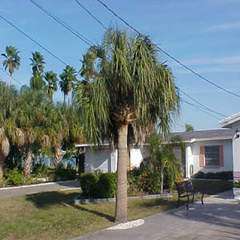SABAL PALM
The Sable Palm is also known as a Texas Palm. Use the Texas palm for formal groupings, as a lawn tree, in large scale plantings and as that special accent tree. Texas palm is best utilized in medium to large yards as the palm may grow 50 ft (15 m) tall and 25 ft (7.6 m) in diameter. Texas palm may be used in a variety of locations as it is tolerant of many soils, wind, drought, and salt.
Florida’s Premiere Tree Installer, The Tree Planters located in Lakeland, is your #1 source for large, rare, and exotic palms and trees. At The Tree Planters, we have installed and transplanted thousands of large trees of every variety all over Florida for over 50 years. Every tree we sell, we plant. Every tree we plant, we guarantee for One Full Year.

Delivery is included in the price of your tree. We proudly serve the entire state of Florida. (All other delivery fees will be quoted at time of purchase), and a One-Year Guarantee on every tree planted by The Tree Planters.
“Note from Joel”
Honestly folks, sometimes I learn something I’ve never known before. Does that happen to anyone else? I’ve been selling trees for several decades and I’ve never heard the Sabal palm referred to as the Texas palm. But what do I know? Those of us on the ground here in Florida that deal with trees every day, who don’t depend for our information on books for the professorial class, know the Sabal palm as the Florida State Tree, and also as the Cabbage palm. You can actually cut the heart out of this tree and guess what it tastes like, yep, cabbage. You can buy this delicacy in many grocery stores. The Cabbage palm is the least expensive palm of them all. This palm isn’t grown commercially because it grows so proficiently in the swampland of Florida. It is cheap to harvest, easy to handle, lives every time you plant one, and generally looks pretty good. This is not one of my favorite palms. To me, it reeks of commonness. However, as all palms do, it has some very good uses. It’s cheap, it grows super slow, and it fills up a small spot quite handily.
Description
This stately, robust palm grows up to 50 ft (15 m) tall with a solitary trunk, 8-32 in (20-81 cm) in diameter. The spread of a mature Texas palm may range from 8 ft (2.4 m) to 25 ft (7.6 m). The gray trunk has closely-spaced annular rings. Usually part of the trunk remains covered with old leaf stem “boots”, that often split at their base. These persistent boots form a characteristic crosshatch pattern on the trunk. The petioles (stems) of the Texas palm are smooth and completely thornless and may grow up to 15 ft (4.6 m) in length. Texas palm has 10-25 fan-shaped leaves ranging in color from deep emerald green, for palms in shade to part shade, and varying to lighter green in color as leaves receive more sunlight. Each leave has 80-115 leaflets with threads along the margins of the leaflets. The leaves of the Texas palm have a prominent and strongly downward arching costa (leaf midrib) which gives the leaves a folded three-dimensional effect. Texas palm may flower when very young, often blooming when the trunk is very small or nonexistent.
Culture
Texas palms tolerate drought and adapt to a wide variety of soils including those that are neutral, acidic, clayey, wet and slightly alkaline. Texas palms thrive in a humid atmosphere in rich loamy, moist and well-drained soils. Texas palms are traditionally slow growers, however regular fertilization with palm grade fertilizer promotes maximum growth. A balanced slow release palm fertilizer with minor elements, e.g., an 18-18-18, may be used during the growing season. Potassium nutritional deficiencies can develop on older leaves and may show up as translucent yellow or orange necrotic spotting. Mineral supplements should be administered in appropriate recommended amounts to prevent or treat such deficiencies. Texas palm is resistant to lethal yellowing disease.
Light: Texas palm thrives in partial shade, partial sun or full sun.
Moisture: The Texas palm is drought resistant when established, but grows faster and looks better when given adequate moisture. Texas palm tolerates moist, wet locations and occasional flooding.
Hardiness: USDA Zones 8 – 11. Mature and established Texas palms can tolerate occasional temperatures down to 12ºF (-11ºC), with minor or no leaf damage. More cold hardy data on the Texas palm is expected as its cultivation becomes more widespread. Some palm enthusiasts are reporting success with growing Texas palm in USDA Zone 7b.